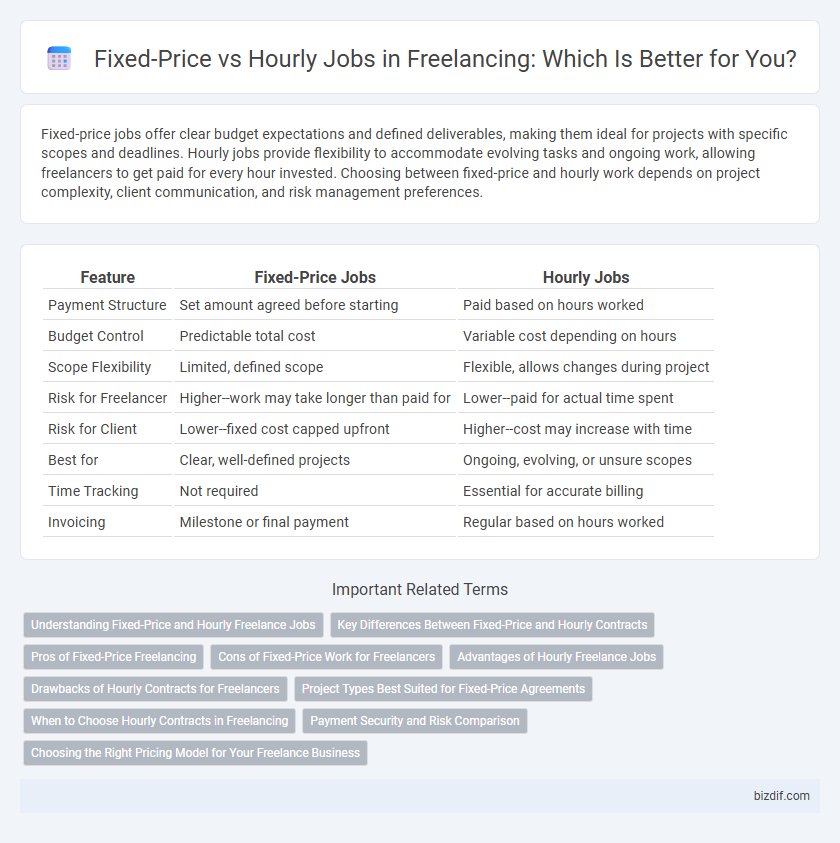Fixed-price jobs offer clear budget expectations and defined deliverables, making them ideal for projects with specific scopes and deadlines. Hourly jobs provide flexibility to accommodate evolving tasks and ongoing work, allowing freelancers to get paid for every hour invested. Choosing between fixed-price and hourly work depends on project complexity, client communication, and risk management preferences.
Table of Comparison
| Feature | Fixed-Price Jobs | Hourly Jobs |
|---|---|---|
| Payment Structure | Set amount agreed before starting | Paid based on hours worked |
| Budget Control | Predictable total cost | Variable cost depending on hours |
| Scope Flexibility | Limited, defined scope | Flexible, allows changes during project |
| Risk for Freelancer | Higher--work may take longer than paid for | Lower--paid for actual time spent |
| Risk for Client | Lower--fixed cost capped upfront | Higher--cost may increase with time |
| Best for | Clear, well-defined projects | Ongoing, evolving, or unsure scopes |
| Time Tracking | Not required | Essential for accurate billing |
| Invoicing | Milestone or final payment | Regular based on hours worked |
Understanding Fixed-Price and Hourly Freelance Jobs
Fixed-price freelance jobs involve a pre-agreed total payment for a completed project, offering clear budget control and defined deliverables, ideal for well-scoped tasks. Hourly freelance jobs compensate based on actual time spent, providing flexibility for evolving project scopes and ongoing tasks but requiring detailed time tracking. Choosing between fixed-price and hourly jobs depends on project complexity, client preferences, and risk management strategies in freelancing.
Key Differences Between Fixed-Price and Hourly Contracts
Fixed-price contracts involve a predetermined total payment, providing clear budget expectations and incentivizing timely project completion, while hourly contracts compensate based on actual time worked, offering flexibility for evolving project scopes. Fixed-price jobs require precise project specifications upfront to avoid scope creep, whereas hourly jobs accommodate ongoing changes and client feedback with adjustable workloads. Choosing between these contracts depends on project clarity, risk tolerance, and preferred payment structure.
Pros of Fixed-Price Freelancing
Fixed-price freelancing offers clear budget expectations, allowing clients and freelancers to agree on a set amount before work begins, which reduces payment disputes and ensures financial predictability. This model encourages efficient project management and results-driven performance, as freelancers are incentivized to complete tasks within the agreed scope and timeline. Fixed-price contracts also provide clients with a straightforward assessment of project costs, enhancing trust and simplifying contract negotiations.
Cons of Fixed-Price Work for Freelancers
Fixed-price jobs often expose freelancers to the risk of underpayment when projects require more time or resources than initially estimated, limiting income potential. Scope creep can cause significant challenges, as clients may expect additional work without adjusting the agreed-upon rate, leading to disputes or uncompensated labor. Lack of flexibility in fixed-price contracts reduces the ability to adapt pricing based on project complexity, hindering fair compensation and long-term profitability.
Advantages of Hourly Freelance Jobs
Hourly freelance jobs provide accurate compensation reflecting the actual time and effort invested, minimizing the risk of underpayment in complex projects. Clients benefit from greater flexibility to adjust project scope and priorities without renegotiating contracts. This payment model enhances transparency and accountability, fostering trust between freelancers and clients.
Drawbacks of Hourly Contracts for Freelancers
Hourly contracts can lead to income instability for freelancers due to fluctuating workloads and unpredictable client demands. Tracking hours precisely may cause administrative burdens and reduce billable time, impacting overall productivity. Clients may also exploit hourly billing by requesting excessive revisions or slower progress, limiting freelancers' earning potential.
Project Types Best Suited for Fixed-Price Agreements
Fixed-price agreements are best suited for projects with well-defined scopes, clear deliverables, and strict deadlines, such as website design, mobile app development, or logo creation. These project types allow freelancers to estimate costs accurately without the risk of scope creep, ensuring budget adherence for both clients and professionals. Fixed-price jobs provide predictability and accountability, making them ideal for tasks that require a specific outcome rather than ongoing work.
When to Choose Hourly Contracts in Freelancing
Hourly contracts in freelancing are ideal for projects with evolving scopes or undefined deliverables where tracking time ensures fair compensation. They benefit clients and freelancers in scenarios requiring ongoing collaboration, frequent revisions, or trial periods. Choosing hourly jobs minimizes the risk of underpayment and supports transparent billing for flexible work arrangements.
Payment Security and Risk Comparison
Fixed-price jobs offer payment security by locking in the agreed amount before work begins, reducing the risk of payment disputes and ensuring freelancers receive compensation upon project completion. Hourly jobs provide ongoing payment but carry the risk of unpaid time if clients delay or dispute hours logged. Choosing between fixed-price and hourly jobs depends on the freelancer's preference for predictable income versus flexible billing aligned with actual work hours.
Choosing the Right Pricing Model for Your Freelance Business
Choosing the right pricing model for your freelance business significantly impacts income stability and client satisfaction. Fixed-price jobs offer predictability and clear project scopes, making them ideal for well-defined tasks, while hourly jobs provide flexibility and fair compensation for ongoing or unpredictable work. Assess project complexity, client communication, and personal work habits to determine whether fixed-price or hourly pricing aligns best with your freelancing goals.
fixed-price jobs vs hourly jobs Infographic

 bizdif.com
bizdif.com